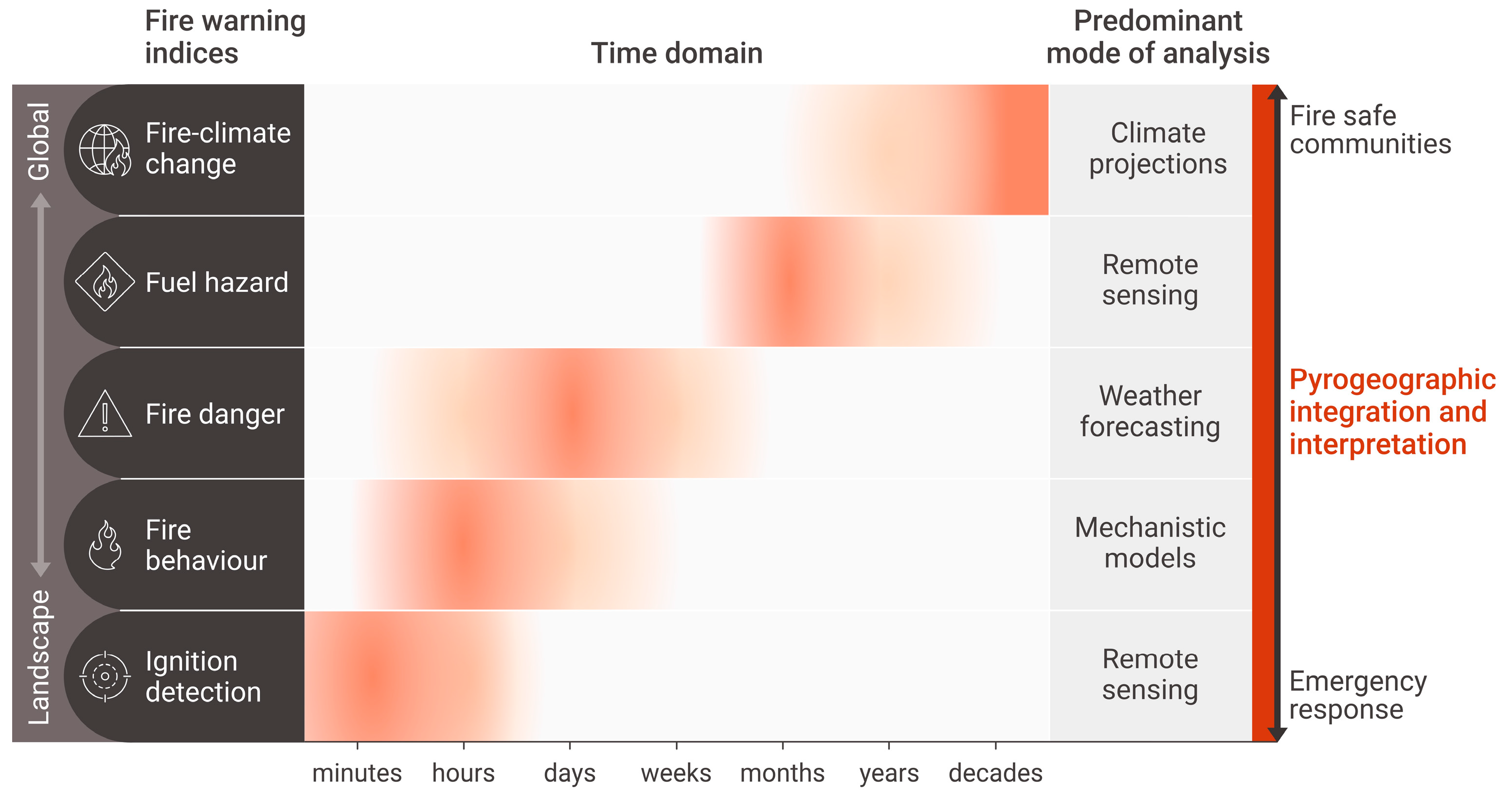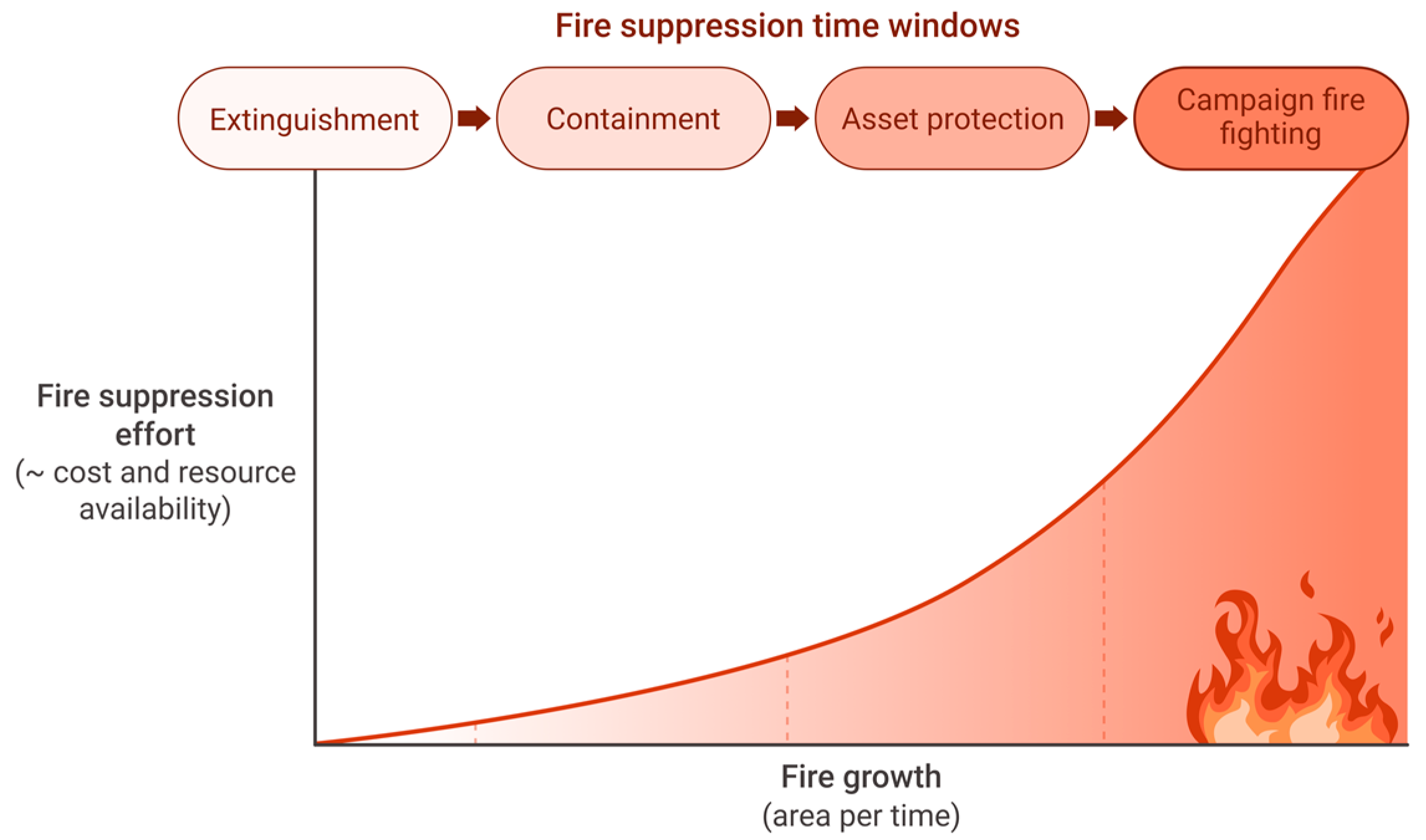Detecting, Monitoring and Foreseeing Wildland Fire Requires Similar Multiscale Viewpoints as Meteorology and Climatology
Abstract
Funding
Institutional Review Board Statement
Informed Consent Statement
Data Availability Statement
Acknowledgments
Conflicts of Interest
References
- Crutzen, P.J.; Ramanathan, V. The ascent of atmospheric sciences. Science 2000, 290, 299–304. [Google Scholar] [CrossRef] [PubMed]
- Petersen, A.C. Philosophy of climate science. Bull. Am. Meteorol. Soc. 2000, 81, 265–272. [Google Scholar] [CrossRef]
- Crowley, M.A.; Stockdale, C.A.; Johnston, J.M.; Wulder, M.A.; Liu, T.; McCarty, J.L.; Rieb, J.T.; Cardille, J.A.; White, J.C. Towards a whole-system framework for wildfire monitoring using Earth observations. Glob. Chang. Biol. 2023, 29, 1423–1436. [Google Scholar] [CrossRef] [PubMed]
- Zimmerman, E.W. Forest Fire Detection; US Department of Agriculture: Washington, DC, USA, 1969; Volume 38.
- Barmpoutis, P.; Papaioannou, P.; Dimitropoulos, K.; Grammalidis, N. A review on early forest fire detection systems using optical remote sensing. Sensors 2020, 20, 6442. [Google Scholar] [CrossRef] [PubMed]
- Simpson, H.; Bradstock, R.; Price, O. A temporal framework of large wildfire suppression in practice, a qualitative descriptive study. Forests 2019, 10, 884. [Google Scholar] [CrossRef]
- Hirsch, K.G.; Martell, D.L. A review of initial attack fire crew productivity and effectiveness. Int. J. Wildl. Fire 1996, 6, 199–215. [Google Scholar] [CrossRef]
- Riley, K.L.; Thompson, M.P.; Scott, J.H.; Gilbertson-Day, J.W. A model-based framework to evaluate alternative wildfire suppression strategies. Resources 2018, 7, 4. [Google Scholar] [CrossRef]
- Alexander, M.E.; Cruz, M.G. Limitations on the accuracy of model predictions of wildland fire behaviour: A state-of-the-knowledge overview. For. Chron. 2013, 89, 372–383. [Google Scholar] [CrossRef]
- Plucinski, M. The timing of vegetation fire occurrence in a human landscape. Fire Saf. J. 2014, 67, 42–52. [Google Scholar] [CrossRef]
- Szpakowski, D.M.; Jensen, J.L. A review of the applications of remote sensing in fire ecology. Remote Sens. 2019, 11, 2638. [Google Scholar] [CrossRef]
- Yebra, M.; Dennison, P.E.; Chuvieco, E.; Riaño, D.; Zylstra, P.; Hunt Jr, E.R.; Danson, F.M.; Qi, Y.; Jurdao, S. A global review of remote sensing of live fuel moisture content for fire danger assessment: Moving towards operational products. Remote Sens. Environ. 2013, 136, 455–468. [Google Scholar] [CrossRef]
- Bowman, D.M.; Kolden, C.A.; Abatzoglou, J.T.; Johnston, F.H.; van der Werf, G.R.; Flannigan, M. Vegetation fires in the Anthropocene. Nat. Rev. Earth Environ. 2020, 1, 500–515. [Google Scholar] [CrossRef]
- Jain, P.; Coogan, S.C.; Subramanian, S.G.; Crowley, M.; Taylor, S.; Flannigan, M.D. A review of machine learning applications in wildfire science and management. Environ. Rev. 2020, 28, 478–505. [Google Scholar] [CrossRef]
- Uccellini, L.W.; Ten Hoeve, J.E. Evolving the National Weather Service to build a weather-ready nation: Connecting observations, forecasts, and warnings to decision-makers through impact-based decision support services. Bull. Am. Meteorol. Soc. 2019, 100, 1923–1942. [Google Scholar] [CrossRef]
- Bowman, D.; Williamson, G.; Yebra, M.; Lizundia-Loiola, J.; Pettinari, M.L.; Shah, S.; Bradstock, R.; Chuvieco, E. Wildfires: Australia needs national monitoring agency. Nature 2020, 584, 188–191. [Google Scholar] [CrossRef] [PubMed]
- AFAC. Australian Fire Danger Rating System (AFDRS). Available online: https://www.afac.com.au/initiative/afdrs/afdrs-overview (accessed on 21 March 2023).
- Whittaker, J.; Haynes, K.; Wilkinson, C.; Tofa, M.; Dilworth, T.; Collins, J.; Tait, L.; Samson, S. Black Summer: How the NSW Community responded To the 2019–20 Bushfire Season; Bushfire and Natural Hazards CRC: East Melbourne, VIC, Australia, 2021. [Google Scholar]
- Bureau of Meteorology. Fire Weather Services. Available online: http://www.bom.gov.au/weather-services/fire-weather-centre/fire-weather-services/ (accessed on 21 March 2023).
- AFAC. Seasonal Bushfire Outlook. Available online: https://www.afac.com.au/docs/default-source/bushfire-seasonal-outlook/seasonaloutlook_summer_2022_v1-0.pdf (accessed on 21 March 2023).
- Bowman, D. Wildfire science is at a loss for comprehensive data. Nature 2018, 560, 7–8. [Google Scholar] [CrossRef] [PubMed]


Disclaimer/Publisher’s Note: The statements, opinions and data contained in all publications are solely those of the individual author(s) and contributor(s) and not of MDPI and/or the editor(s). MDPI and/or the editor(s) disclaim responsibility for any injury to people or property resulting from any ideas, methods, instructions or products referred to in the content. |
© 2023 by the author. Licensee MDPI, Basel, Switzerland. This article is an open access article distributed under the terms and conditions of the Creative Commons Attribution (CC BY) license (https://creativecommons.org/licenses/by/4.0/).
Share and Cite
Bowman, D.M.J.S. Detecting, Monitoring and Foreseeing Wildland Fire Requires Similar Multiscale Viewpoints as Meteorology and Climatology. Fire 2023, 6, 160. https://doi.org/10.3390/fire6040160
Bowman DMJS. Detecting, Monitoring and Foreseeing Wildland Fire Requires Similar Multiscale Viewpoints as Meteorology and Climatology. Fire. 2023; 6(4):160. https://doi.org/10.3390/fire6040160
Chicago/Turabian StyleBowman, David M. J. S. 2023. "Detecting, Monitoring and Foreseeing Wildland Fire Requires Similar Multiscale Viewpoints as Meteorology and Climatology" Fire 6, no. 4: 160. https://doi.org/10.3390/fire6040160
APA StyleBowman, D. M. J. S. (2023). Detecting, Monitoring and Foreseeing Wildland Fire Requires Similar Multiscale Viewpoints as Meteorology and Climatology. Fire, 6(4), 160. https://doi.org/10.3390/fire6040160





